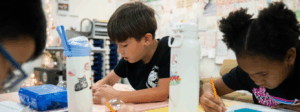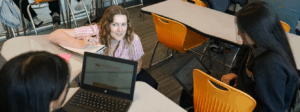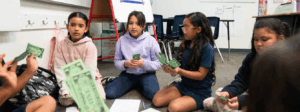Across the country, states and school systems have been shifting literacy instruction to align with the evidence-based science of reading approach at a rapid pace. At TNTP, we’re excited to see the momentum growing, as the districts and states we’ve been partnering with over the past several years have been achieving impressive outcomes for students. But from our work in the field, we know that achieving those results starts with changing instructional practice, and changing practice takes time, collaboration, and support from school and system leaders.
Now that the school year is in full swing, it’s an ideal time to take stock of the systems and structures you’ve put in place for literacy instruction. Your teachers have completed science of reading training—check. Your school has invested in high-quality instructional materials for literacy—check. But do teachers have what they need to put those investments to good use in the classroom? Whether it’s your school’s first year implementing science of reading curricula or you’ve got a few years under your belt, the questions below can help you assess if your school is on-track for bringing the science of reading to life in every classroom.
1. Do you understand the science of reading?
The better you understand the science of reading as a school leader, the more effective you’ll be at supporting educators and students. Fully embracing the science of reading approach may require you and your educators to shift mindsets and confront longstanding misconceptions and myths that have held low-income students, students of color, multilingual learners, and students with learning and thinking differences back for decades. It requires understanding how the brain learns to read, the structure of languages, and the cultural and power dynamics that are bound up in language.
This is challenging work, and the best way to support your team is to roll up your sleeves and dig into it yourself. Contact us to enroll in TNTP’s online Science of Teaching Reading course to get the foundation you’ll need.
2. Do you have a clear vision for evidence-based literacy instruction?
When you articulate a vision of what you want to be true for all students in literacy, you and your team will not only know where you’re headed, but also why it matters that you get there. At TNTP, we ask our school partners to start by setting a clear vision for what they want high-quality literacy instruction to be in every classroom, for every learner, with special attention paid to the needs of students who have been historically marginalized. All instructional efforts should work in service of that vision.
3. Are you giving teachers regular feedback on data-informed priorities?
Student data is a powerful tool to help you stay focused on the shared priorities you set with your team. As a school leader, the feedback you share with your educators will be most impactful when your observations are also focused on those shared priorities, so that the team can continue refining their practice and making progress toward fulfilling your shared vision.
4. Have you set consistent time and protocols for educators to prepare for instruction together?
As educators begin to implement the new, high-quality literacy curricula in their classrooms, it’s inevitable that they will encounter challenges and have questions. When you give your teachers time and techniques to wrestle with those challenges together, you’ll increase alignment across classrooms while providing another layer of support and collaboration to help them succeed. It’s a win-win.
5. Have you authentically engaged families as partners in your literacy improvement efforts?
Parents, caregivers, and family members are essential partners in the success of your literacy program; they are the experts on their students, and they can support and reinforce at home what students are learning in school. But for that to work, they have to know what you’re working toward and how they can help. Start by providing opportunities for them to learn about your vision for literacy, and introduce them to the materials their children will be using. Help caregivers support their students in embracing all of their languages, whether that is the language of instruction in school, or the language they are loved in at home. Don’t forget to schedule these opportunities in ways that make it possible for caregivers to fully engage, whether that’s by offering childcare, language interpretation support, or both day and evening sessions.
Reflecting on your school’s science of reading efforts early in the school year means there’s still plenty of time to course-correct and get on-track to achieving your literacy vision. You are uniquely positioned to understand the theory, support your educators with meaningful, targeted feedback, encourage teacher collaboration, and engage your school community as partners in the work. And when you bring those elements together, your team can achieve amazing results for students, who deserve the best literacy instruction possible.
Partner with us. TNTP offers a range of science of reading services, including asynchronous online training courses for educators, academic diagnostics to determine where and how to improve, and support selecting and implementing high-quality instructional materials. Contact us to learn more.







